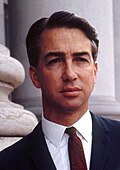Background
The drop in major party primary votes was due to the socially progressive Liberal Movement (LM) led by Robin Millhouse who achieved 18.3 percent of the primary vote and 2 seats. The party was a breakaway faction of the Liberal and Country League (LCL) which disbanded in 1973, the party which was the predecessor to the South Australian Division of the Liberal Party of Australia. Stemming from discontent within the ranks of the LCL, it was first formed by former premier Steele Hall as an internal group in 1972 in response to a lack of social and acceptance of electoral reform within the LCL. A year later, when tensions heightened between the LCL's conservative wing and the LM, it was established on its own as a progressive liberal party. When still part of the league, it had eleven representatives; on its own, it initially had three.
The election was fought with the Liberal Party, the Liberal Movement, and the Country Party all competing for votes against Labor, in the background of the Labor Prime Minister Gough Whitlam scandals, with this election taking place six months before the governor general dismissed the Whitlam government resulting in his defeat at the December 1975 federal election.
Results
The Liberals received a 50.8 percent two-party vote to Labor on 49.2 percent. The Liberals, Liberal Movement, and Country Party held a combined 23 seats, as did Labor. The balance of power was held by independent MP Ted Connelly, the mayor of Port Pirie. Connelly sided with Dunstan and accepted his offer of Speaker of the South Australian House of Assembly.
The LM won two seats (both sitting members: Robin Millhouse and David Boundy). When the LM joined the Liberal Party in 1976, Boundy joined the Liberals while Millhouse created the New LM; after which the numbers were Labor 23, Liberal 21, Country Party 1, New LM 1, and 1 independent supporting Labor (Connelly).
The 1975 election saw permanent large two-party swings away from Labor in a few rural seats − 13.5 percent in Chaffey, 15.5 percent in Mount Gambier and 16.4 percent in Millicent.
It was the first time that a Labor government in South Australia had been re-elected for a third term, and would be the first seven-year-incumbent Labor government.
The election was also the first in South Australia where both major parties contested all lower house seats.
Historically, the Legislative Council (the upper house) had been dominated by an LCL majority for decades due to the Playmander electoral malapportionment as well as the limit on upper house voting rights to the wealthier classes with suffrage dependent on certain property and wage requirements. However they were highly independent and often obstructive to both major parties. Originally the Legislative Council had fixed staggered terms and elections were held separately from lower house elections, which would later be changed by the introduction of joint elections in the 1980s.
The 1975 election saw the introduction of universal suffrage for the Legislative Council and the introduction of a statewide single electorate. It also increased the number elected at each election from 10 to 11, meaning the house increased from 20 to 21 members, and would become a 22-member house from 1979 onwards.
Labor won 6 seats, the Liberal Party won 3, and the Liberal Movement won 2; giving total numbers of Labor 10, Liberal 9, and Liberal Movement 2; giving the Liberal Movement the balance of power. The Liberal Movement members rejoined the Liberal Party in 1976, giving the Liberals a majority in the upper house.
This page is based on this
Wikipedia article Text is available under the
CC BY-SA 4.0 license; additional terms may apply.
Images, videos and audio are available under their respective licenses.



